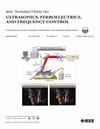求解逆问题的超声定位显微镜计算超分辨率。
IF 3.7
2区 工程技术
Q1 ACOUSTICS
IEEE transactions on ultrasonics, ferroelectrics, and frequency control
Pub Date : 2025-03-21
DOI:10.1109/TUFFC.2025.3553735
引用次数: 0
摘要
超声定位显微镜(ULM)代表了传统超声成像(US)的重大进步,通过使用微泡(mb)作为高反射造影剂,可以实现微血管结构的超分辨率(SR)成像,具有前所未有的细节。注入血液后,MBs被定位在US图像上重建微血管。然而,该技术面临MB定位精度和捕获时间之间的权衡。低MB浓度的灌注减少了信号重叠,实现了较高的定位精度,但需要延长采集时间。相反,较高的MB浓度缩短了采集时间,但增加了信号重叠,限制了定位精度。传统的ULM包括五个主要步骤:组织过滤、MB检测、MB超定位、跟踪和渲染。在本研究中,我们提出了一种将鲁棒主成分分析(RPCA)与计算SR技术相结合的新方法,将ULM的前三个步骤替换为基于求解SR逆问题的单个过程。该方法将MB信号从背景噪声中分离出来,增强了重叠MB的定位,从而提高了ULM的整体性能。模拟和体内数据的实验结果表明,我们提出的方法将SR因子提高了30%,并将对比度(CR)提高了3.5 dB。它还可以在其他图像质量指标上产生可比的结果。这些改进使血管图像更加密集,对比度更高。本文章由计算机程序翻译,如有差异,请以英文原文为准。
Computational Super-Resolution for Ultrasound Localization Microscopy Through Solving an Inverse Problem
Ultrasound localization microscopy (ULM) represents a significant advancement over traditional ultrasound (US) imaging, enabling super-resolution (SR) imaging of microvascular structures with unprecedented detail, by using microbubbles (MBs) as highly reflective contrast agents. After injection into the bloodstream, MBs are localized in US images to reconstruct the microvasculature. However, this technique faces a tradeoff between MB localization accuracy and acquisition time. Perfusion with low MB concentrations reduces signal overlap and achieves high localization accuracy but requires extended acquisition times. Conversely, higher MB concentrations shorten acquisition times but increase signal overlap, limiting localization precision. Traditionally, ULM consists of five main steps: tissue filtering, MB detection, MB super-localization, tracking, and rendering. In this study, we present a novel approach that combines a robust principal component analysis (RPCA) with a computational SR technique, replacing the first three steps of ULM with a single process based on solving an SR inverse problem. This method isolates MB signals from background noise and enhances the localization of overlapping MBs, thereby improving overall ULM performance. The experimental results from simulated and in vivo data demonstrate that our proposed approach increases the SR factor by up to 30% and enhances the contrast ratio (CR) by 3.5 dB. It also produces comparable results across other image quality metrics. These improvements enable denser, higher contrast vascular images.
求助全文
通过发布文献求助,成功后即可免费获取论文全文。
去求助
来源期刊
CiteScore
7.70
自引率
16.70%
发文量
583
审稿时长
4.5 months
期刊介绍:
IEEE Transactions on Ultrasonics, Ferroelectrics and Frequency Control includes the theory, technology, materials, and applications relating to: (1) the generation, transmission, and detection of ultrasonic waves and related phenomena; (2) medical ultrasound, including hyperthermia, bioeffects, tissue characterization and imaging; (3) ferroelectric, piezoelectric, and piezomagnetic materials, including crystals, polycrystalline solids, films, polymers, and composites; (4) frequency control, timing and time distribution, including crystal oscillators and other means of classical frequency control, and atomic, molecular and laser frequency control standards. Areas of interest range from fundamental studies to the design and/or applications of devices and systems.

 求助内容:
求助内容: 应助结果提醒方式:
应助结果提醒方式:


